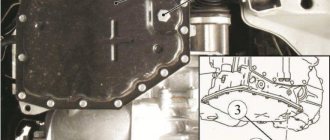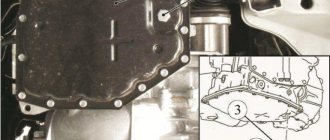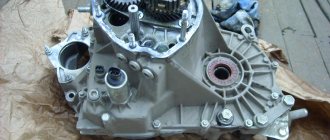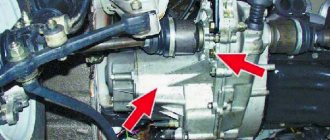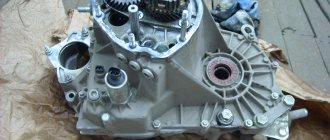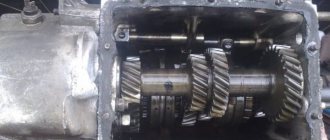The joint production of AvtoVAZ and Renault equipped Lada Largus cars with five-speed gearboxes. Depending on the configuration, gearboxes marked JR5 and JH3 are installed.
On more common versions with a 1.6-liter 8-valve engine and a 1.6-liter 16-valve engine, a JH3 manual transmission is installed.
The maintenance regulations do not provide for changing the oil in the Lada Largus gearbox. Although cars are adapted for harsh operating conditions, it is recommended to carry out lubricant diagnostics every 15,000 km.
This is done using a visual inspection. It is enough to unscrew the filler plug at the end of the box closer to the cooling radiator.
Causes and signs of oil losing its properties
If the transmission fluid is darkened or black in color, this may indicate that the lubricant has undergone a chemical change as a result of severe contamination with wear products of the gearbox elements (gear shafts and synchronizers) or a violation of the tightness of the gearbox (moisture and dirt entering through the seals of the drives or input shaft ).
- The smell of burnt oil in Lada Largus. May indicate insufficient lubrication levels due to leaks. Under heavy loads on the unit, cooling of the rubbing parts is not adequately ensured.
- If shifting gears is difficult, you may hear some noise or hum at certain speeds or when idling. The lubricating properties of the transmission fluid are partially lost or the level in the gearbox housing is insufficient.
- Increased wear of gearbox elements. Aggressive driving style and incorrect gear shifting.
- Mileage over 60,000 km since previous replacement. It is at this interval that service stations recommend replacing the transmission fluid.
What kind of oil to pour into a manual gearbox Lada Largus
Lada Largus is the best-selling Russian station wagon. Good driving characteristics, a spacious interior, high comfort and reliability - all these qualities made the car popular even on the secondary market. The simple design allows you to maintain the car yourself, and thereby save on repairs. So, during self-service, one of the most popular procedures is not only replacement, but also selection in the gearbox. Any motorist can handle this. And yet, even experienced car enthusiasts may have questions about this. In this article we will take a closer look at how to choose the right oil for a Lada Largus manual transmission.
Let's consider the criteria for choosing transmission oil for Lada Largus. The question of choosing a suitable lubricant for a manual transmission usually arises after 15-20 thousand kilometers, when it is time to change the fluid. The Russian station wagon is equipped with two types of gearboxes – JH1 (for a 1.4-liter engine) and jH3 (for a 1.6-liter engine). Both boxes have a certain clutch housing size, and all other characteristics are absolutely similar. But despite this fact, the two gearboxes support the same oil with identical parameters, which will be discussed later in the article.
Oil selection
The manufacturer uses transmission lubricant ELF TRANSELF TRJ 75W-80 (No. 194757) or 75W-90 (No. 195286).
Good analogues include Casrtol Syntrans Transaxle 75W-90 and Motul Gear300 75 W-90. All of the listed oils have the necessary API specification tolerances: GL - 4. They have high lubricating and detergent properties.
The use of lubricants for a Lada Largus car with a different approval is not recommended. A different additive package may affect the functional qualities of soft metal box elements (synchronizers).
Semi-synthetic lubricants, for the most part, have mineral substances, some synthetic substances and a certain percentage of additives responsible for enhancing the properties of oils.
Synthetic fluids are based only on synthetic substances. Produced from hydrocacking substances with the addition of additives.
Synthetic gear lubricants have better characteristics than semi-synthetic ones, but are more expensive.
The choice of oil viscosity depends on the climatic operating conditions of Largus. Thicker lubricants have proven themselves to be excellent in hot conditions. Technical fluids with lower viscosity require less time to warm up in sub-zero temperatures.
Gearbox malfunctions and methods for eliminating them
Any mechanism has a tensile strength, especially if it operates under variable loads. It is necessary to take into account the driver's driving style, which significantly affects the durability of the part. Summarizing the accumulated experience and analysis of breakdowns that occur during the operation of the car, gearbox faults can be grouped into several main groups: noise in the gearbox, difficulty engaging the gear and spontaneous shutdown of the transmission.
Noise and difficulty shifting gears
The main causes of noise in the gearbox include:
- low oil level;
- water entering the system;
- wear of bearings or gears.
To fix the problem, you should add or replace the oil in the gearbox, replace the bearings and gears with new ones.
Difficulty shifting gears can be caused by the following factors:
- faulty gearbox control rod;
- loosening of fastenings;
- deformation of control drive parts;
- wear of synchronization rings;
- incomplete disengagement of the clutch.
The listed faults can easily be eliminated by adjusting the clutch and replacing deformed and worn parts. It also helps to adjust the mechanisms in accordance with the regulations indicated in the car’s operating manual.
Spontaneous transmission shutdown
The reasons for spontaneous shutdown of the gearbox are usually:
- gear wear;
- damage occurs on the rubber supports of the box;
- wear of the synchronizer rings.
These faults can only be corrected by replacing them with new parts. Do-it-yourself transmission repair requires high qualifications and a set of special tools. Only a competent specialist can remove and disassemble this part correctly.
If the gearbox malfunctions, it is better to contact a service station, where they will not only repair the unit, but will also give you a guarantee that you can use in the event of a subsequent gearbox breakdown.
Step-by-step instruction
Changing the oil in the box is carried out on a well-warm-up car.
Important! The temperature of the transmission fluid in the box of the Lada Largus should be 60 degrees. It is determined by a special device - a scanner. If this is not the case, the car warms up to the operating temperature of the internal combustion engine. The gearbox lubricant temperature will correspond to 60 degrees. This will facilitate good oil drainage. Fig 3
- For access and convenience, we drive the car onto an overpass or inspection hole.
- Apply the parking brake.
- We turn on the transmission.
- We go down into the inspection hole and remove the engine protection. Six 10mm bolts.
- Unscrew the plastic filler plug by hand. Using a special four-sided wrench, remove the drain plug.
- Drain the oil into the prepared container. If there were no leaks, we get approximately 2.5-2.8 liters of waste. The full volume of 3.1 liters cannot be drained due to the design features of the upper row of gears.
- We replace the sealing washer with a new copper or aluminum one.
- We wipe the drain neck with a rag and screw the clean plug back on. Tighten with a force of 30 Hm. We use a torque wrench. If there is no key, tighten the wrench tightly enough to avoid possible oil leaks. But not too much, so as not to spoil the edges and break the thread.
- Using a syringe, fill in new transmission fluid through the filler hole. If you don’t have a syringe, take a hose with an outer diameter of no more than 16 mm and a funnel. Open the hood of the car and, through the top, insert the hose into the filler neck.
- Fill with oil until grease flows out of the same hole. The filler hole is also a control hole. The lower level, which is the norm. Before tightening the filler plug, inspect the sealing rubber for integrity.
- If necessary, to eliminate smudges, replace the rubber band or plug assembly with a new one. We start the car for a few minutes. Then we inspect the gearbox for oil leaks.
- Reinstall the engine protection.
- To carry out work on replacing the gearbox lubricant of a Lada Largus car, you can turn to professionals or do the work yourself.
Is it worth changing the oil in manual transmissions at all - video
Checking the level and topping up
Before changing or adding lubricant, you should check the oil level in the box. This is not as difficult to do as many may think. If you have minimal experience and skills, you can easily cope with the task with your own hands. In the case of a Lada Largus car, for work you will need to take:
- a syringe that will be used to add the missing liquid;
- rags;
- an empty container for several liters;
- key square for 8;
- oil similar to what is in the box.
Special syringes are used, available in auto parts stores. Do not confuse them with medical syringes, which are not suitable for such purposes. Special topping and filling tools have a hose that allows easy access to the filler neck. When everything is ready, you can begin to assess the amount of oil in the box and add the missing amount of lubricating fluid to the Largus gearbox.
The work is carried out according to the following algorithm of actions:
Remove the engine protection. People often call it the central mudguard. The essence does not change from the name. Find the filler plug, which can often be easily unscrewed with a square wrench. Before opening the cap, place an empty prepared container under it to avoid spilled puddles of oil. According to the standards, the level should be located slightly below the filler hole. If it is less, then you will need to add the missing amount of gear lubricant. A syringe pre-filled with oil is inserted into the filler neck. Gradually pour in the viscous liquid. At some point, lubricant will begin to flow through the hole.
Wait until it stops running completely, then wipe everything with a rag and screw the plug back into place. During the process of checking and topping up, pay attention to the condition of the rubber O-ring on the plug. If the machine is used for a long time and actively, the ring may wear out
It is better to replace it immediately, since a worn seal will break the seal and the oil will gradually leak out. Such a ring costs about 5 - 10 rubles, so serious expenses for such repairs will not be required.
If you did everything correctly, the oil is not leaking anywhere and the gearbox is functioning normally, then the transmission fluid level is sufficient and you can continue to operate your car.
see also
Comments 30
I replaced the 5th gear gear and after 1500 km I changed the oil and filled it with Mobile 75-90. Until I changed the oil on the 5th there was not much noise, after the change everything was fine.
Immediately after buying the car, I bought the same three liters, but never changed the oil in the box. As a result, I’m thinking of changing it to 75w90 oil, most likely mobilube or motul gear 300.
I decided to fill the Renault box with Renault oil :)
I changed mine at about 24,000 km, everything was fine before, after the replacement, I can say that the gears immediately began to turn on poorly, that is, worse than before. Now the mileage is 39,000 km, sometimes it is impossible to turn on the first one, I turn it on through the second one. If the first one does not turn on, then I turn on the second one and quickly start the first one. The remaining gears are engaged but with noticeable resistance. I suspect underfilling of oil. I remember when I was changing it, I drained about 2.5 liters, but only filled in 2, it didn’t fit anymore, but somehow I didn’t attach much importance to it, I took 5 liters, I thought that if something else then I’ll add more. Then, long after the replacement, I accidentally watched a video where it turns out that it seems necessary to jack up the left side of the car and then the oil will fill completely. I recently bought 3 liters of fresh one, I’ll be changing it again soon. The 3 liters that I had left from the last replacement went to the chainsaw)))
Let me know when you change it again. I filled it to the level until it leaked out of the filler neck. The car was parked on a level surface
Mine was also level, I filled it until it started leaking. I'll definitely let you know. Subscribe to my car, and then you will see my blog entry in your feed. I will most likely do a report next week, I will finish the repairs in the garage.
I changed mine at about 24,000 km, everything was fine before, after the replacement, I can say that the gears immediately began to turn on poorly, that is, worse than before. Now the mileage is 39,000 km, sometimes it is impossible to turn on the first one, I turn it on through the second one. If the first one does not turn on, then I turn on the second one and quickly start the first one. The remaining gears are engaged but with noticeable resistance. I suspect underfilling of oil. I remember when I was changing it, I drained about 2.5 liters, but only filled in 2, it didn’t fit anymore, but somehow I didn’t attach much importance to it, I took 5 liters, I thought that if something else then I’ll add more. Then, long after the replacement, I accidentally watched a video where it turns out that it seems necessary to jack up the left side of the car and then the oil will fill completely. I recently bought 3 liters of fresh one, I’ll be changing it again soon. The 3 liters that I had left from the last replacement went to the chainsaw)))
Read more: Pump nsh 50 characteristics
I would like to know what oil is filled now and what kind you will fill... Oil for manual transmission - Choice: www.drive2.ru/l/509881750902539127/
From the factory, the engines of my 2012s were filled with ELF, the one above at the beginning of the entry in the photos, I bought myself exactly 3 of these, liters each. Before this, I used the same ELF, only a 5 liter canister.
I have already spoken on various topics, at the Auto Exhibition in Moscow, AvtoVAZ employees said, if there is noise, play with the oil...
I agree with you, recently in my UAZ, at high speeds (70+), the 5th gear began to howl. I suspected that there was no oil in the transfer case because... a little dripped from it. It turned out that there was no oil not only in the transfer case but also in the gearbox. Filled it up, the howling disappeared, the gears began to engage like on a passenger car, and before that like on a tractor)). In general, I got off easy because I started fussing during the time, well, like during the 2 weeks, then I drove around with a howl, it turns out that without oil. But this is UAZ, and this is Renault.
Oil tends to lose its intended properties, few people think about it... that is, to burn out, when I drove Estima I changed the automatic transmission oil every 15 tkm, and if I drove more, I would have ruined the box... after 15 tkm the automatic transmission growled and screamed -silk... and before this run, there was almost* silence...
Well, an automatic transmission requires a much more detailed selection of oil and its replacement intervals than a manual transmission.
The boxes have the same purpose, but with different capabilities, but the driving style is different for everyone, from here, and the manufacturer makes gearbox oil - GL-4 and GL-5... - translated: for speed and moderate driving...
I also changed the oil in the manual transmission at 10,000 km and immediately in the engine, it became much quieter and the shifts became better, although there were no problems before, the car drives differently, which means that the ros-and-oil needs to be replaced - with good oil, especially for manual transmission!
There is a difference for the better!
Not that word. Even the sound of all components has changed - on the move...
I also changed the oil in the manual transmission at 10,000 km and immediately in the engine, it became much quieter and the shifts became better, although there were no problems before, the car drives differently, which means that the ros-and-oil needs to be replaced - with good oil, especially for manual transmission!
Read more: How to increase the ground clearance of a VAZ 2110
I support, I did the same, changed everything to Motul...
Changing the oil in the Lada Largus gearbox, according to the manufacturer, should not be carried out until the resource is exhausted. But many car enthusiasts perform this operation in order to replace the oil fluid with a different viscosity or when repairing a gearbox.
Adviсe
- Before starting work, travel at least 10-15 km so that the oil inside the gearbox warms up and becomes less viscous.
- If the sealing gasket of the filler plug is not torn and is elastic, it can be reinstalled.
- Pay attention to the processing status. The presence of an emulsion indicates mixing of oil and water. Often such a nuisance is a consequence of a leak in the boot of the inner CV joint of the left drive shaft. Therefore, inspect the boot for tears or loose clamps. Pay attention to the transmission breather, through which, if installed incorrectly, water and dirt enter the manual transmission. Often, after unqualified repairs, craftsmen neglect the correct installation of the breather. 4.For preventive purposes, rinse and blow out the breather with compressed air. As the pressure inside the transmission increases, a completely clogged "breather" valve can push out. If the malfunction is not noticed in time, dust, dirt and moisture will render the new gear oil unusable.
5. We recommend lubricating the engine protection mounting bolts with graphite grease.
Seal
When is it necessary to change transmission fluid?
To avoid serious gearbox problems, you should monitor the oil level. Also, pay attention to its condition. It should not have an unpleasant odor or metal shavings. A scheduled check of the transmission should occur every 15,000 km.
The danger of operating the Lada Largus is caused by engine tripping. The main reason for this is the use of inadequate quality oil. The machine must be subject to full professional diagnostics in a specialized service center.
Premature replacement of the transmission fluid is possible if, during operation of the Lada, extraneous noise appears and the gears do not work well. If you have difficulty shifting gears, you also need to check the oil level in the manual transmission of your car.
Thus, Lada Largus is a car that can be used for commercial purposes. The car may have a 1.6 liter engine. The transmission is set to “mechanics”. In some cases, it is possible to solve the problem of the functioning of the high-speed gearbox by replacing the transmission fluid.
Lubricant replacement
If a regular oil change in the gearbox is not able to bring the Lada Largus owner the expected result, then you will have to resort to a complete replacement of the lubricant in the transmission unit. This work is also not difficult, so it can be done by a novice owner.
We use a similar set as a list of tools. Unlike the topping up procedure, here you will need to worry about the presence of the full volume of oil that needs to be replaced. According to regulatory requirements from the manufacturer, this amount is equal to three liters. We also do not recommend experimenting, but using gearbox oil that complies with the regulatory postulates of the technical manual.
Buy lubricant with a small supply to save yourself from the troublesome search and purchase during the future need for refilling. Decide which oil is best for your car.
Having prepared all the specified tools, we perform the following list of actions:
- we install our Lada Largus over the pit (you can also hang it with a lifting device);
- We prepare a container that can hold the specified volume of liquid;
- first unscrew the plug on the filler hole, which will speed up the draining process;
- Now we move to the drain plug and carefully unscrew it (it is recommended to warm up the box before replacing the lubricant);
- drain the liquid, waiting for it to completely drain;
- upon completion of this moment, return the plug to its place, not forgetting to replace the seal;
- Next, we begin the process of pouring oil through the neck of the same name; we do this slowly, allowing the viscous oil to gradually leave the cavity of the syringe and fill the crankcase of the unit;
- Often it is not possible to drain 100% of the used lubricant, so after filling, not 3 liters are placed, as indicated in the regulations, but a little less;
- We fill the transmission housing with “fresh” lubricant until a return current appears from the hole;
- now all that remains is to thoroughly wipe the area of the transmission housing directly adjacent to the filler neck with a rag;
- install the plug in its original place, tightening it to the required torque;
- we start the 16-valve engine of the Lada Largus car and make a series of gear changes in the box, which will allow the new lubricant to be optimally distributed inside the transmission unit (this is important before starting to drive, when the gearbox begins to experience load).
That's all, the gearbox oil has been changed.
Let's sum it up
In practice, it has been reliably established that procedures such as topping up or changing gearbox oil in a Lada Largus transmission with a 16-valve engine are in no way associated with difficulties. This allows inexperienced owners, without a shadow of a doubt, to resort to such repair actions when the need arises. Note that the factory recommends replacing the fluid after 200,000 miles, although in reality this interval can be significantly reduced. In any case, monitor the level and what kind of oil you are pouring, that is, its condition (color, smell, presence of chips, etc.) of the oil in the transmission after the scheduled interval and then you will have complete information about the real need for replacement or topping up.
Source
5 manual transmission (JR5)
Available configurations and prices
If a five-speed manual transmission is enough for comfortable driving around the city or on the highway, then you can safely choose the option with a manual transmission5. This unit is identified by the code JR5 according to the Renault company classification. This transmission is equipped with cars in the “Life” (basic configuration) and “Drive” modifications with front-wheel drive and a 1.6-liter engine. The cost is 1,015,000 rubles. and 1105990 rub. respectively.
Specifications
JR5 has been designed by the company's engineers for a long time and has been successfully used on other Renault, Lada and Nissan models for many years. Therefore, it was decided to use it on the new representative of the model range.
Gear ratios
One of the main characteristics of the transmission is rightfully the gear ratio in each gear. Below are the data for 5 manual transmission.
- 3,727.
- 2,048.
- 1,321.
- 0,971.
- 0,738.
Design
This gearbox was not created from scratch. The basis was taken from an old design marked JH3 and reworked to suit modern needs. The basis remains the same: a two-shaft arrangement using synchronizers in all stages and combining with the main gear and differential into one system.
Among the improvements made by engineers, experts note:
- Installation of a hydraulic clutch, which replaced the use of a cable. By such actions, a softer moment of changing gear stages was achieved.
- Direct activation is now carried out by two flexible cables, and not by a rigid rod, as before. This made it possible to remove vibrations inside the unit.
- The Renault Arcana manual transmission in 5 gears can withstand 200 Nm, while its predecessor only 160. The difference of almost 25% is quite noticeable.
The working cylinder and bearing are combined into one unit and bolted to the crankcase.
Most of the box is made of aluminum and steel alloys. High-quality sealants are used to seal the product. The teeth of the reverse gears are different - they are straight, not oblique, as for all the other five. Different types of secondary shaft bearings are used, namely ball and roller.
Exploitation
Resource
According to Renault company representatives, the service life of the JR5 gearbox without repairs or breakdowns can be 250 thousand kilometers. After this, if not earlier, of course, adventures will begin in the form of repairs or replacement of individual components. To prevent this from happening, you need to keep an eye on the box. The first thing is to change the oil on time, do not overload in cold or very hot seasons, and do not transport cargo more than allowed in the technical specifications. In practice, with a gentle operating mode without major repairs, it turns out to “run back” twice as much
Change of oil
According to the scheduled list of replacement works, a mask is not provided for in the Renault Arcana manual transmission. But service center specialists insist on changing the fluid every 60 thousand mileage. The procedure will not cost the owner very much, but will significantly extend the life of the unit. To change, you need to use branded oil ELF Tranself NFJ 75W80. For a complete replacement, 2.5 liters will be enough.
Consumption
Let us remind you that only front-wheel drive Renault Arcana with a 1.6-liter engine are equipped with a manual transmission5. According to the passport data, the consumption should be 7.1 liters of AI-95 gasoline. In practice, the indicator may be higher or lower depending on various factors.
The Renault Arcana 5-speed manual transmission is not a new development, but an improved unit. Therefore, all serious shortcomings in it have been eliminated long ago. Of those that are relevant
It can still be noted: Frequent and constant oil seal leaks.
